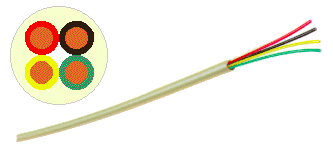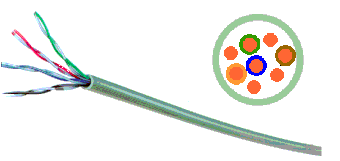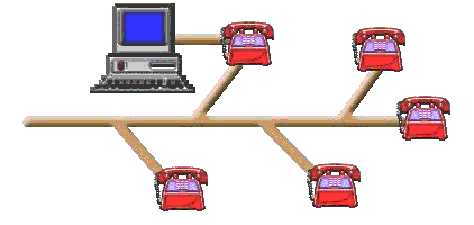| Communications Cables |
Revised: 08/22/99 18:42 |
| Residential
Phone Wire Basics |
Reason for Revision: Add header |
If you haven't
reviewed the pages on Color Codes: Pair Identification by
Conductor Color and Categories of
Cable Transmission Performance, you may wish to do so before proceeding
with the information on this page.
There is a good chance
that your home has one or both of the following conditions in
its phone wiring:
1. Wire made of individual conductors and
not pairs.
2. Some combination of bridge taps and
daisy chains.
Both conditions are
widely encountered in residential installations. Until
recently, when data connections and multiple lines became
common in the home, they were acceptable. Unfortunately, they
both contribute significantly to poor transmission quality
and may make installation of a second phone line or data
communication via fax or modem a near impossibility.
[The term
"pair" is used generically to describe a telephone
circuit. For this discussion, however, when I use the word
"pair" I mean the physical twisting of one
conductor with a mate to form a balanced circuit. As I use
the word circuit, it means the electrical loop formed by
either two parallel conductors or a twisted pair.]
A phone circuit
consists of an electrical loop. Two wires laying parallel are
more than adequate to accomodate voice communications. In
fact, the earliest telephone signals were sent using one
metallic conductor and the earth itself as the other
conductor in the loop!
Much residential phone
wiring (called Station Wiring) is made with either 2, 3, or 4
insulated conductors bunched together and jacketed. The bunch
may or may not be twisted along its length, but the point is
that any two conductors connected to form a circuit are
essentially parallel to each other. I will refer to this as conductorized
Station Wire, or simply SW.
In this design signal
loss due to crosstalk noise is very likely. If you've ever
had a phone call in which you could hear (but couldn't
pariticpate in) another conversation, you've experienced
crosstalk. It is the partial transfer of the signal on one
circuit to a nearby circuit in the cable.
The best circuit for
transmission is a well balanced pair of insulated conductors,
twisted together at regular intervals. In a cable with
multiple pairs, this helps isolate the signals being sent
along a pair from other signals being sent on neighboring,
parallel pairs. In order to further isolate the signals, the
interval of twists is different pair to pair. Isolating the
signals in this way helps prevent crosstalk.
The lay length or
twist length of a pair is the distance from one twist to
another. Its complement is referred to as the number of
twists per foot (TPF). For example, a pair with a lay length
of 3 inches has 4 TPF (12 inches per foot/3 inches per
twist.) There is a correlation between the lay length of the
twists and reduction in crosstalk. In general, the shorter
the twist length, the better the crosstalk.
A typical exchange,
distribution, or drop cable in the Outside Plant, or Category
3 or lower Premises cable, has twist lengths which range from
around 2 inches (6 TPF) to a maximum of 6 inches (2 TPF). In
a typical 25 pair unit (remember the color code scheme?),
each pair has its own, unique, lay length.
Categories 4 and 5
have much more stringent crosstalk requirements than Category
3 and so the twist lengths are much shorter or
"tighter". Category 5 cables typically have twist
lengths less than 1.5 inch (more than 8 TPF).
Getting back to the
residential installation, millions of feet per year of
conductorized SW is put into homes. Noisy, poor quality
circuits result when second phone lines are added. This
becomes critical when fax machines or modems are expected to
operate over one of the lines.
How can you tell what
you've got?
 |
SW is color
coded according the the alternate system of
red/green, yellow/black for pairs one and two.
When you strip back the jacket for a foot or
more, it should be evident that no two conductors
particularly belong to each other. When you look
at the cable in cross section, the jacket should
have filled in the spaces around the conductors,
although this may not always be the case. Four
conductor wire is commonly referred to as
"quad" SW. |
| SWT (Station
WIre, Twisted pairs) usually has the standard
color code of Blue/White, Orange/White for pairs
one and two. When you strip back the jacket for a
foot or so, at least some of the pairs should be
obvious. (SWT may meet, or comes close to,
Category 3 performance. Pair twist lengths are
usually in the 2 to 6 inch range.) In cross
section, the jacket will look like a tube, or
straw, with the pairs laying in the tube.
CAUTION: Some paired designs do use the alternate
color code system. |
 |
If you are fortunate
enough to have 2, 3, or 4 pair wire already in your home,
adding a second phone line or getting good data transmission
has been made easier for you.
A bridge tap is a way
of creating an extension by splicing into a main wire which
leads back to where the telephone service enters your house.
In a bridge tap scenario, your wiring ends up looking like a
fishbone diagram.
Daisy chains are
similar. In a daisy chain, each extension is wired in series
with the next one down the line.

|
Bridge
Tap/Daisy Chain
|
What's wrong with
these two methods? Each connection splice and termination
weakens the signal. Each one becomes a point of potential
noise in the circuit or causes attenuation, mainly through
impedance mismatches.
Installers compensate
for these practices, and for the potential poor signal
quality in a conductorized cable, by using 22 AWG wire. The
larger copper conductor in a 22 AWG cable compared to a 24
AWG product means lower resistance, which translates directly
into less inherent attenuation of the signal. Category 3
cable in 24 AWG is capable of 16 MHz of bandwidth over a 100
meter (328 foot) distance. Category 5 in 24 AWG has 100 MHz
of bandwidth for the same distance. Clearly, 22 AWG
conductors are not necessary for the residence. The irony is,
for not much more cost than a 4 conductor 22 AWG Station
Wire, an installer could purchase 2 pair, or even 4 pair, 24
AWG Station Wire Twisted.
What is becoming a
widespread recommendation by communications professionals is
to star-wire your home in a manner similar to the structured
wiring schemes being implemented in commercial installations.
In such a scheme, each extension is "home-run" or
"star" wired with a single cable being installed
from each wall plate back to a central point where the
telephone service enters the home. Such a scheme provides
maximum flexibility for assignment of separate voice and data
outlets and also allows for a future home LAN.

|
Home-run/Star
Wiring
|
There are ways to
compensate for your home's existing wiring. For example, my
old house was wired with 3 pair SWT, which is good, but it
was daisy-chained, which is not-so-good. A second phone line
installed by the phone company works fine for both voice and
fax. For my modem connection, however, I ran a new Category 3
cable from the wall outlet in my office directly back to the
Network Interface Unit on the outside of the house.
Return
to Notebook Page 1



